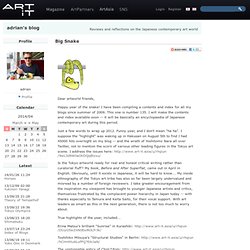

巳年. Dear artworld friends, Happy year of the snake!

I have been compiling a contents and index for all my blogs since summer of 2009. This one is number 135. I will make the contents and index available soon -- it will be basically an encyclopaedia of Japanese contemporary art during this period. Just a few words to wrap up 2012. Is the Tokyo artworld ready for real and honest critical writing rather than curatorial fluff? True highlights of the year, included... Erina Matsui's brilliant "Sunrise" in Kurashiki: Toshihiko Mitsuya's "Structural Studies" in Berlin: The unstoppable antics of Chim↑Pom: The emergence centre stage of SHIBUHOUSE, with great work by curator Shai Ohayon: "End of War in the 2010s" at eitoeiko: Some sublime "in the country" moments at Echigo-Tsumari (thanks to Julian and Miwa), especially at Hibino's asate village, and the BankArt refuge: & The artworld event of the year at Mizuma, the Matsukage Wedding Party: And four great shows, I was able to review, bookended the year:
Interview with the organizer of TOKYO FRONTLINE, Shigeo Goto - Topics - Online Gallery of Japanese Contemporary Art Azito. TOKYO FORNTLINE's organizer, Mr. Shigeo Goto We were excited to have an opportunity to hear a story from TOKYO FRONTLINE's organizer, Mr. Goto about art fairs in Japan and Japanese contemporary art world. TOKYO FRONTLINE's interesting and novel projects were born from his background as an art book editor and as a professor at Kyoto University of art and design. Mr. TOKYO FORNTLINE's venue, 3331 Arts Chiyoda I realized that how Japanese art market is ossified, coming in touch with foreign art fair. HIVE » 活動記録 / ドキュメント » ICC 活動記録 2011-2012. A Place In My Art. M (Event Bar & Space). Photo by Vanessa Franklin; models: Ines Kljakovic, Julien Sato The first art gallery space as we know it is said to be the Palais du Louvre, opened as a museum in 1793 by the French Revolutionary government.
By 1863, sufficient opposition to the narrow views of the artistic establishment led to the opening of the Salon des Refusés featuring work by “rejected” artists. This process occurred in Japan, too, with the Meiji government’s first western-style exhibition, the Bunten, quickly garnering criticism as being élitist and conservative. Since then, Japan’s artistic reactions against the establishment have taken different forms, like the mass production of socially critical art magazines in the early 20th century, and avant-garde movements such as the Hi-Red Center in the ’60s, who responded to the government’s pre-Olympics clean-up of the city by heading out in white suits to “clean” it themselves.
M employs a similar system. The idea of M is a neutral platform.